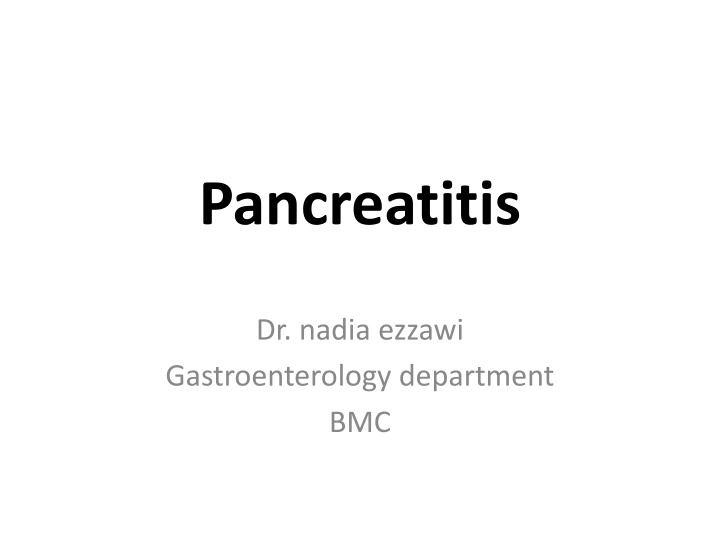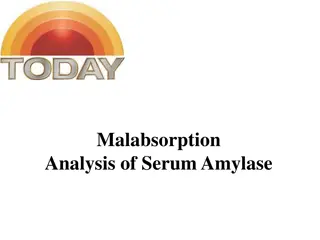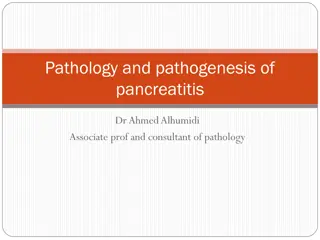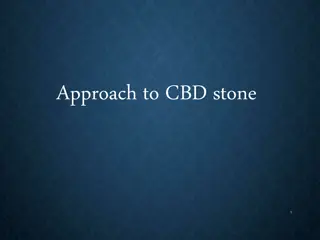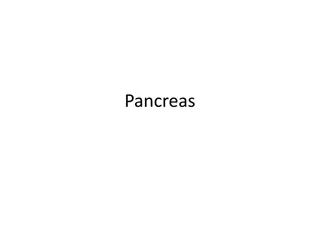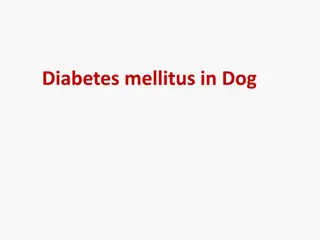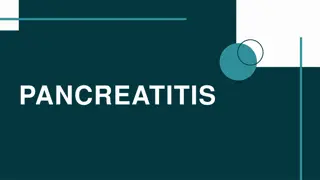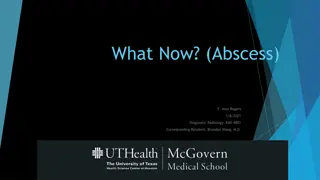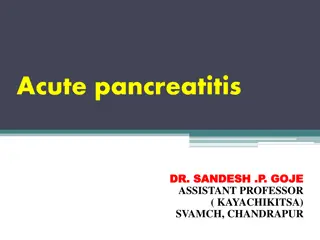Pancreatitis
Acute pancreatitis is an inflammatory condition of the pancreas. Learn about its definition, types, clinical features, complications, and treatment options. Explore the anatomy, physiology, and blood supply of the pancreas along with physiological classifications. Discover the differences between mild and severe acute pancreatitis and other classifications based on physiological findings and imaging. Understand the complexities of this condition for effective management.
Download Presentation

Please find below an Image/Link to download the presentation.
The content on the website is provided AS IS for your information and personal use only. It may not be sold, licensed, or shared on other websites without obtaining consent from the author.If you encounter any issues during the download, it is possible that the publisher has removed the file from their server.
You are allowed to download the files provided on this website for personal or commercial use, subject to the condition that they are used lawfully. All files are the property of their respective owners.
The content on the website is provided AS IS for your information and personal use only. It may not be sold, licensed, or shared on other websites without obtaining consent from the author.
E N D
Presentation Transcript
Pancreatitis Dr. nadia ezzawi Gastroenterology department BMC
objectives Anatomical and physiological back ground. Difinition and types of pancreatitis. Clinical features and complications of disease and their management.
Pancreas: Anatomy and Physiology Retroperitoneal organ . It is almost completely covered by the stomach and duodenum . 15-20cm in length Head, neck, body and tail curves behind the superior mesenteric vessels
Pancreas: blood supply HEAD Superior pancreatoduodenal A. (from gastroduodenal A.) Inferior pancreatoduodenal A. (from SMA) BODY AND TAIL superior pancreatic A. pancreatic magna A. transverse pancreatic A. VEIN to splenic vein ,SMV and portal vein
Physiology Exocrine the acinar cells produce digestive juices, which are secreted into the intestine and are essential in the breakdown and metabolism of proteins, fats, and carbohydrates. Endocrine A cell glucagon B cell insulin D cell somatostatin G cell gastrin
Pancreatitis Difinition :- It is an inflammatory process of the pancrease with associated escape of pancreatic enzymes into surrounding tissues. Classified into:- Acute Pancreatitis. Chronic Pancreatitis
Acute pancreatitis It is an acute inflammatory process of the pancreas, accompanied by abdominal pain and elevations of serum pancreatic enzymes. It has Variable severity and duration. Abrupt onset and unpredictable course.
Classification based on physiological findings, laboratory values, and radiological imaging Mild Acute pancreatitis (MAP). Mild disease is not associated with complications or organ dysfunction and recovery is uneventful. Severe Acute pancreatitis (SAP). severe pancreatitis is characterized by pancreatic dysfunction, local and systemic complications, and a complicated recovery.
Other classification: -- acute interstitial pancreatitis. the gland architecture is preserved but is edematous. Inflammatory cells and interstitial edema are prominent within the parenchyma -- acute hemorrhagic pancreatitis. characterized by marked necrosis, hemorrhage of the tissue, and fat necrosis. There is marked pancreatic necrosis along with vascular inflammation and thrombosis.
Etiology of acute pancreatitis. Biliary tract disease . Abuse of ethanol. Trauma and operation. Ischemia of pancreas. Drugs (azathioprine). Idiopathic pancreatitis. Hypercalcemia . Hyperlipidemia . Infections and Parasites . Procedure .(Endoscopic retrograde cholangiopancreatography )
Pathogenesis Self digestion , oedema and necrosis . Reflux of bile or duodenal juice Trypsinogen was activated Release of the enzymes------ fat necrosis in both pancreatic and peritoneal cavity . Collection of pancreatic enzymes form pancreatic pseudocyst.
Clinical manifestations Abdominal pain Nausea, vomiting abdominal Distension abdominal Tenderness, rebound tenderness, muscular regard Fever jaundice Gray-Turner sign: flank ecchymoses Cullen sign: periumbilical ecchymoses MODS(multiple organ dysfunction syndrome )
laboratory test High Amylase level in serum and in urine( increased renal clearance). High Lipase level ( more specific). Blood :impaired RFT, liver function, high BS, low PaCO2 , Raised serum calcium, DIC manifestations. Imaging studies USS: especially if the cause is stones, abcess, hge. CT : Important finding include pancreatic swelling, peripancreatic fluid collection, an area of non enhancement because of necrosis. ERCP. MRCP. Abdomen plain film.
Diagnosis Ransons criteria On admission Within 48hrs Age > 55 years Hematocrit decrease by > 10% WBC >16,000mm Urea nitrogen increase > 5mg/ dl LDH > 350IU/l Serum calcium < 8 mg/dl Glucose > 200mg/dl Arterial Po2 <60 mmhg AST > 250 IU /L Base deficit > 4 mEq/L Estimated fluid sequestration > 6L
Glasgow criteria Age >55 Glucose > 180 mg/dl Urea > 45 mg/dl WBC > 1500 mm Albumin < 3.2 g/dl Arterial Po2 < 60mmhg LDH > 600 Calcium < 8mg/dl
Complications of acute pancreatitis Pancreatic necrosis( relaese of pancrearic lipase) Pancreatic abscess Pancreatic pseudocyst Acute pancreatic pseudocyst:- Collection surrounded by fibrous tissue or granular tissue. Peripancreatic fluid Those persisting beyond the phase of acute inflammation become pancreatic pseudocysts.
Treatment of acute pancreatitis Non Operative trearment: ICU to prevent MODS fasting the patient, nasogastric suction Minimizing pancreatic secretion antacids Fluid replacement and Nutritional support maintenance of adequate hydration TPN glucose ,lipid, amino acid, protein Analgesia Antibiotics Abdominal lavage
operative Indication of Operation: Biliary obstruction Secondary pancreatic infection Undetermined diagnosis, needs laparotomy. Surgery usually is drainage of fluids, abscess. Methods Percutaneous drainage Operative drainage Cystgastrostomy, cystjejunostomy Resection of pancreatic body and tail
Chronic pancreatitis It is benign inflammatory process and fibrosing disorder characterized by - irreversible morphologic changes, - progressive and - permanent loss of exocrine and endocrine function .
Clinically the disease is characterized by recurrent episodes of sever and uncontrollable upper abdominal pain and by a loss of exocrine function (diarrhea , steatorrhea) and endocrine function ( DM).
Clinical manifestations abdominal pain: may be continuous, intermittent or absent Pattern is often atypical RUQ or LUQ of the back Diffuse throughout upper abdomen May be referred to the anterior chest or flank Typical form: Persistent , deep-seated, Unresponsive to antacids Worsened by alcohol intake or a heavy meal (especially fatty foods) Often need narcotics
Pancreatic insufficiency Weight loss Fat malabsorption: Steatorrhea: 15% of patients present with steatorrhea and no pain. Pancreatic diabetes: Like DM1 needs insulin , but risk of hypoglycemia is more than DM (because alfa cells is also affected). Fat-soluble vitamin deficiency rare
Etiology - toxic metabolic Idiopathic Genetic / hereditory Autoimmune / immunologic Recurrent acute acute pancreatitis Obstructive /mechanical
Lab data Amylase and lipase : usually normal CBC ,electrolytes, and liver function tests are typically normal Bilirubin and ALP may be increased Impaired glucose intolerance and elevated fasting blood glucose Sudan staining of feces or quantitative test for steatorrhea fecal elastase (Among pancreatic function tests, fecal elastase measurement is the most sensitive and specific, especially in the early phases of pancreatic insufficiency)
Classic triad pancreatic calcification , steatorrhea , and diabetes mellitus usually establishes chronic pancreatitis Classic triad : found in fewer than one-third It is often necessary to perform secretin stimulation test (abnormal when 60% or more of pancreatic exocrine function has been lost) A decreased serum trypsinogen (<20ng/ml) or a fecal elastase level of <100ug/mg of stool strongly suggests severe pancreatic insufficiency
Imaging study CT, MRI, US calcifications ductal dilatation enlargement of the pancreas fluid collections (eg, pseudocysts
ERCP May provide useful information on the status of the pancreatic ductal system Abnormalities include : 1)luminal narowing 2)irregularities in the ductal system with stenosis, dilation,saculation,and ectasia 3)blockage of the duct by calcium deposits Endoscopic ultrasonography The most predictive endosonographic feature is the presence of stone
Complications of chronic pancreatitis pseudocyst formation bile duct or duodenal obstruction pancreatic ascites or pleural effusion splenic vein thrombosis Pseudoaneurysms pancreatic cancer acute attacks of pancreatitis( particularly alcoholics who continue drinking)
Treatment Establish a secure diagnosis. Cessation of alcohol intake. Small meals. Pancreatic enzyme supplements. Patients should also be treated with acid suppression (either with an H2 receptor blocker or a proton pump inhibitor) to reduce inactivation of the enzymes from gastric acid. Analgesics
pancreatitis can be suspected clinically, but requires, biochemical, radiologic, and sometimes histologic evidence to confirm the diagnosis. measurement of amylase and lipase are useful for diagnosis of pancreatitis. Imaging studies helps in diagnosis and comlication detection .
